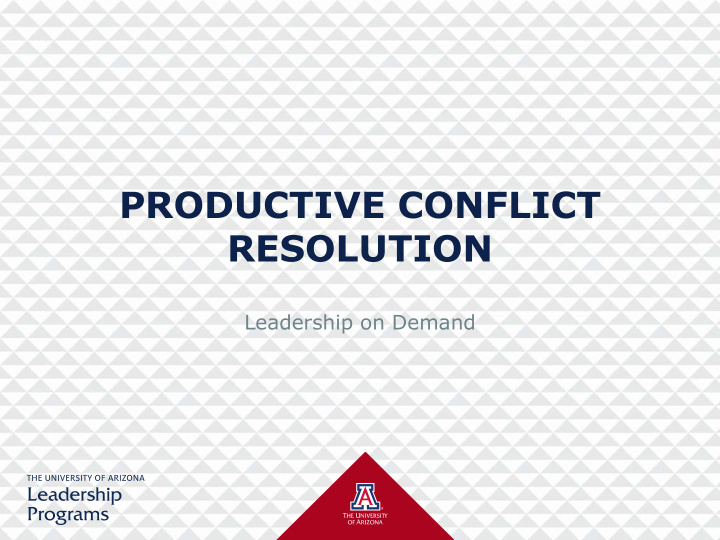



PRODUCTIVE CONFLICT RESOLUTION Leadership on Demand
AGENDA Overview • Style Assessment • Case Study • Conflict Resolution Tips •
WHAT IS CONFLICT? Conflict : A disagreement between two or more parties Causes: Incompatible goals, values, or interests • Miscommunication • Incomplete or Misinformation • Competition • Personality clashes • Habits and patterns •
ADVANTAGES AND DRAWBACKS Advantages Drawbacks Increase self awareness Debilitating Increase motivation and energy Distracts from goal achievement Clarifies issues and positions Creates defensiveness and rigidity Can lead to innovation and creativity Tends to escalate and proliferate more issues
STYLE ASSESSMENT – PART 1 1. I tenaciously argue my position. 2. I try to put the needs of others above mine. 3. I try to arrive at a compromise both parties can accept. 4. I try not to get involved in conflicts. 5. I strive to thoroughly, jointly investigate conflicts. 6. I try to find fault in the other person’s position. 7. I strive to foster harmony. 8. I negotiate to get a portion of what I propose. 9. I avoid open discussions of controversial subjects. 10. I openly share information with others in solving disagreements. 1=Rarely 2=Occasionally 3=Sometimes 4=Often 5=Very often
STYLE ASSESSMENT – PART 2 11. I enjoy winning an argument. 12. I go along with the suggestions of others. 13. I look for a middle ground to resolve disagreements. 14. I keep my true feelings to myself to avoid hard feelings. 15. I encourage the open sharing of concerns and issues. 16. I am reluctant to admit I am wrong. 17. I try to help others to take the lead in resolving controversy. 18. I stress the advantage of “give and take.” 19. I encourage others to take the lead in resolving controversy. 20. I state my position as only one point of view. 1=Rarely 2=Occasionally 3=Sometimes 4=Often 5=Very often Dunnette, M.& Thomas, K.W. (1976). Conflict and conflict management. Handbook of Industrial and Organizational Psychology, 889-935. Chicago, IL: Rand McNally.
STYLE ASSESSMENT – SCORING Group 1: Group 2: Group 3: Group 4: Group 5: Competing Accommodating Compromising Avoiding Collaborating 1 2 3 4 5 6 7 8 9 10 11 12 13 14 15 16 17 18 19 20 Total: Total: Total: Total: Total:
CASE STUDY You are excited to begin your experience as a member of the student programming board the last week of training where you have met 12 other new board members and 2 returners, Melanie and Keisha. The experienced board members are really helpful in sharing information and insights, but you are starting to find their involvement in training to be overbearing. Just yesterday, the group was brainstorming topics that should be discussed in small committee meetings and Melanie and Keisha referred to topics that worked and didn't work last year. Just this afternoon, someone suggested that the group chalk sidewalks across campus welcoming people, and both women entered the conversation stating that chalking was unprofessional and that last year they used their budget to buy professionally printed banners to welcome students to campus. You are noticing that others on the Board are starting to show frustration with the ongoing references to "last year" and are discussing this with each other. You know that if the frustration continues it could hurt the overall efficiency and success of student programming board team, and you suspect that Melanie and Keisha are not aware of how their behavior and responses might be stifling idea sharing and team trust. What might you do in this situation? Be specific about how you would respond.
CONFLICT STYLES REVIEW Competing Accommodating Compromising Avoiding Collaborating Assertive and Unassertive and Unassertive and Assertive and Intermediate Uncooperative Cooperative Uncooperative Cooperative Hides from Works with the Overpower Self sacrifice Middle Ground problem other person Relationships are Mutually Identifies Neglects personal of minor acceptable Sidesteps issue underlying concerns importance solution problems Other person’s Generosity or Direct address of Does not address Explore expense charity issue conflict disagreement Yielding to another Splitting the Win/Lose outcome Withdrawing Creative solution point of view difference Dunnette, M.& Thomas, K.W. (1976). Conflict and conflict management. Handbook of Industrial and Organizational Psychology, 889-935. Chicago, IL: Rand McNally.
DEALING WITH CONFLICT: THE THOMAS/KILMANN MODEL
TIPS FOR CONFLICT RESOLUTION Be proactive instead of reactive. • Be slow to anger-especially over petty issues. • Instead of telling people they are wrong, point out • mistakes indirectly. Look for some type of common ground as soon as • possible. If you find that you are in the wrong, admit it. • Admit one of your own poor decisions before pointing • out a similar error by others. Mend fences whenever possible. • Staneart, D. (n.d.) Workplace conflict resolution tips. Retrieved July 24, 2008 from http://www.leadersinstitute.com.
THANK YOU! Leadership Programs SUMC 404 leadershipondemand@email.arizona.edu
Recommend
More recommend